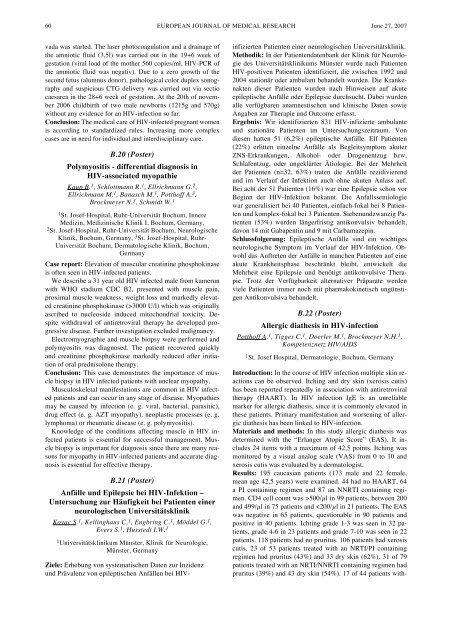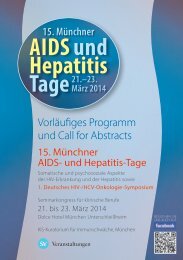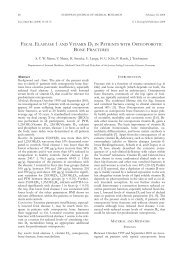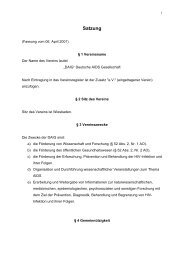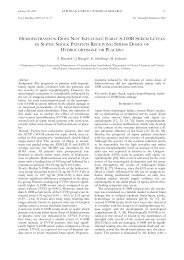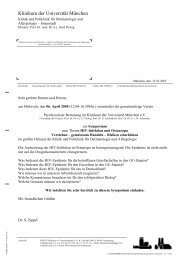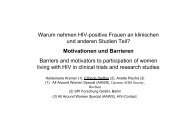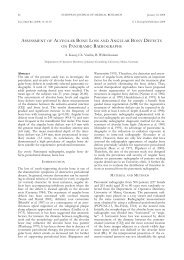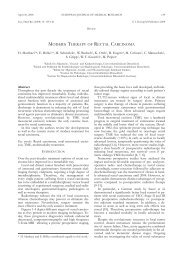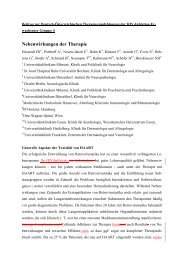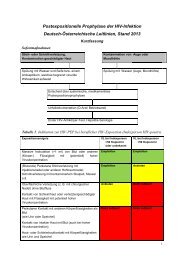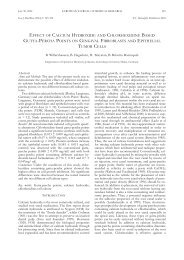European Journal of Medical Research - Deutsche AIDS ...
European Journal of Medical Research - Deutsche AIDS ...
European Journal of Medical Research - Deutsche AIDS ...
Create successful ePaper yourself
Turn your PDF publications into a flip-book with our unique Google optimized e-Paper software.
60 EUROPEAN JOURNAL OF MEDICAL RESEARCH<br />
June 27, 2007<br />
vada was started. The laser photocoagulation and a drainage <strong>of</strong><br />
the amniotic fluid (3,5l) was carried out in the 19+6 week <strong>of</strong><br />
gestation (viral load <strong>of</strong> the mother 560 copies/ml, HIV-PCR <strong>of</strong><br />
the amniotic fluid was negativ). Due to a zero growth <strong>of</strong> the<br />
second fetus (alumnus donor), pathological color duplex sonography<br />
and suspicious CTG delivery was carried out via sectio<br />
caesarea in the 28+6 week <strong>of</strong> gestation. At the 20th <strong>of</strong> november<br />
2006 childbirth <strong>of</strong> two male newborns (1215g and 570g)<br />
without any evidence for an HIV-infection so far.<br />
Conclusion: The medical care <strong>of</strong> HIV-infected pregnant women<br />
is according to standardized rules. Increasing more complex<br />
cases are in need for individual and interdisciplinary care.<br />
B.20 (Poster)<br />
Polymyositis - differential diagnosis in<br />
HIV-associated myopathie<br />
Kaup B. 1 , Schlottmann R. 1 , Ellrichmann G. 2 ,<br />
Ellrichmann M. 1 , Banasch M. 1 , Potth<strong>of</strong>f A. 3 ,<br />
Brockmeyer N. 3 , Schmidt W. 1<br />
1 St. Josef-Hospital, Ruhr-Universität Bochum, Innere<br />
Medizin, Medizinische Klinik I, Bochum, Germany,<br />
2 St. Josef-Hospital, Ruhr-Universität Bochum, Neurologische<br />
Klinik, Bochum, Germany, 3 St. Josef-Hospital, Ruhr-<br />
Universität Bochum, Dermatologische Klinik, Bochum,<br />
Germany<br />
Case report: Elevation <strong>of</strong> muscular creatinine phosphokinase<br />
is <strong>of</strong>ten seen in HIV-infected patients.<br />
We describe a 31 year old HIV infected male from kamerun<br />
with WHO stadium CDC B2, presented with muscle pain,<br />
proximal muscle weakness, weight loss and markedly elevated<br />
creatinine phosphokinase (>3000 U/l) which was originally<br />
ascribed to nucleoside induced mitochondrial toxicity. Despite<br />
withdrawal <strong>of</strong> antiretroviral therapy he developed progressive<br />
disease. Further investigation excluded malignancy.<br />
Electromyographie and muscle biopsy were performed and<br />
polymyositis was diagnosed. The patient recovered quickly<br />
and creatinine phosphokinase markedly reduced after initiation<br />
<strong>of</strong> oral prednisolone therapy.<br />
Conclusion: This case demonstrates the importance <strong>of</strong> muscle<br />
biopsy in HIV infected patients with unclear myopathy.<br />
Musculoskeletal manifestations are common in HIV infected<br />
patients and can occur in any stage <strong>of</strong> disease. Myopathies<br />
may be caused by infection (e. g. viral, bacterial, parasitic),<br />
drug effect (e. g. AZT myopathy), neoplastic processes (e. g.<br />
lymphoma) or rheumatic disease (e. g. polymyositis).<br />
Knowledge <strong>of</strong> the conditions affecting muscle in HIV infected<br />
patients is essential for successful management. Muscle<br />
biopsy is important for diagnosis since there are many reasons<br />
for myopathy in HIV-infected patients and accurate diagnosis<br />
is essential for effective therapy.<br />
B.21 (Poster)<br />
Anfälle und Epilepsie bei HIV-Infektion –<br />
Untersuchung zur Häufigkeit bei Patienten einer<br />
neurologischen Universitätsklinik<br />
Kovac S. 1 , Kellinghaus C. 1 , Engbring C. 1 , Möddel G. 1 ,<br />
Evers S. 1 , Husstedt I.W. 1<br />
1 Universitätsklinikum Münster, Klinik für Neurologie,<br />
Münster, Germany<br />
Ziele: Erhebung von systematischen Daten zur Inzidenz<br />
und Prävalenz von epileptischen Anfällen bei HIV-<br />
infizierten Patienten einer neurologischen Universitätsklinik.<br />
Methodik: In der Patientendatenbank der Klinik für Neurologie<br />
des Universitätsklinikums Münster wurde nach Patienten<br />
HIV-positiven Patienten identifiziert, die zwischen 1992 und<br />
2004 stationär oder ambulant behandelt wurden. Die Krankenakten<br />
dieser Patienten wurden nach Hinweisen auf akute<br />
epileptische Anfälle oder Epilepsie durchsucht. Dabei wurden<br />
alle verfügbaren anamnestischen und klinische Daten sowie<br />
Angaben zur Therapie und Outcome erfasst.<br />
Ergebnis: Wir identifizierten 831 HIV-infizierte ambulante<br />
und stationäre Patienten im Untersuchungszeitraum. Von<br />
diesen hatten 51 (6,2%) epileptische Anfälle. Elf Patienten<br />
(22%) erlitten einzelne Anfälle als Begleitsymptom akuter<br />
ZNS-Erkrankungen, Alkohol- oder Drogenentzug bzw.<br />
Schlafentzug, oder ungeklärter Ätiologie. Bei der Mehrheit<br />
der Patienten (n=32, 63%) traten die Anfälle rezidivierend<br />
und im Verlauf der Infektion auch ohne akuten Anlass auf.<br />
Bei acht der 51 Patienten (16%) war eine Epilepsie schon vor<br />
Beginn der HIV-Infektion bekannt. Die Anfallssemiologie<br />
war generalisiert bei 40 Patienten, einfach-fokal bei 8 Patienten<br />
und komplex-fokal bei 3 Patienten. Siebenundzwanzig Patienten<br />
(53%) wurden längerfristig antikonvulsiv behandelt,<br />
davon 14 mit Gabapentin und 9 mit Carbamazepin.<br />
Schlussfolgerung: Epileptische Anfälle sind ein wichtiges<br />
neurologische Symptom im Verlauf der HIV-Infektion. Obwohl<br />
das Auftreten der Anfälle in manchen Patienten auf eine<br />
akute Krankheitsphase beschränkt bleibt, entwickelt die<br />
Mehrheit eine Epilepsie und benötigt antikonvulsive Therapie.<br />
Trotz der Verfügbarkeit alternativer Präparate werden<br />
viele Patienten immer noch mit pharmakokinetisch ungünstigen<br />
Antikonvulsiva behandelt.<br />
B.22 (Poster)<br />
Allergic diathesis in HIV-infection<br />
Potth<strong>of</strong>f A. 1 , Tigges C. 1 , Doerler M. 1 , Brockmeyer N.H. 1 ,<br />
Kompetenznetz HIV/<strong>AIDS</strong><br />
1 St. Josef Hospital, Dermatologie, Bochum, Germany<br />
Introduction: In the course <strong>of</strong> HIV infection multiple skin reactions<br />
can be observed. Itching and dry skin (xerosis cutis)<br />
has been reported repeatedly in association with antiretroviral<br />
therapy (HAART). In HIV infection IgE is an unreliable<br />
marker for allergic diathesis, since it is commonly elevated in<br />
these patients. Primary manifestation and worsening <strong>of</strong> allergic<br />
diathesis has been linked to HIV-infection.<br />
Materials and methods: In this study allergic diathesis was<br />
determined with the “Erlanger Atopie Score” (EAS). It includes<br />
24 items with a maximum <strong>of</strong> 42,5 points. Itching was<br />
monitored by a visual analog scale (VAS) from 0 to 10 and<br />
xerosis cutis was evaluated by a dermatologist.<br />
Results: 195 caucasian patients (173 male and 22 female,<br />
mean age 42,5 years) were examined. 44 had no HAART, 64<br />
a PI containing regimen and 87 an NNRTI containing regimen.<br />
CD4 cell count was >500/�l in 99 patients, between 200<br />
and 499/�l in 75 patients and


